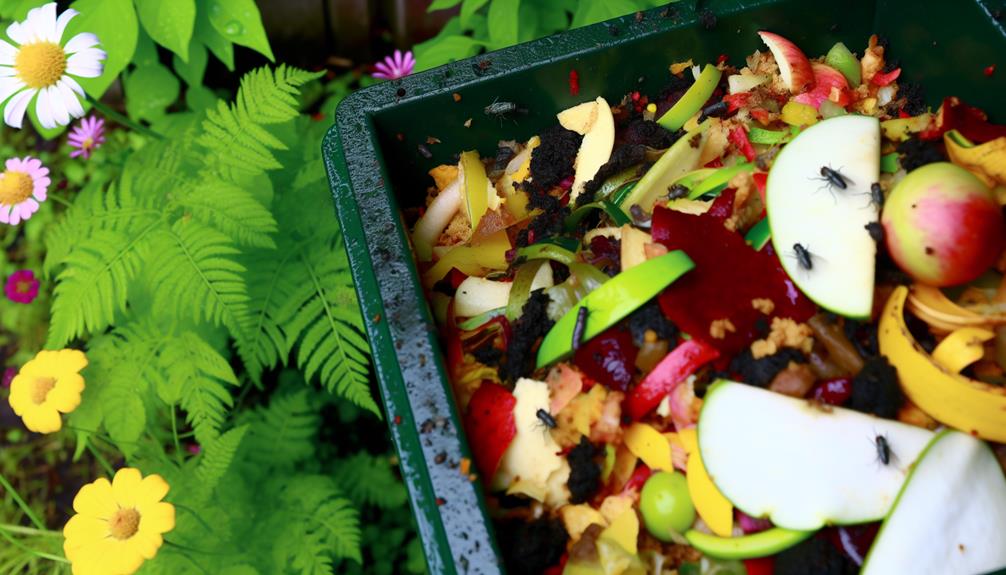

Yes, you can compost cake, but it’s not the best idea. Cake’s sugary content attracts pests like rats and mice, disrupting your compost pile. Additionally, it doesn’t offer much nutritional value or bulk, making it harder for the pile to stay balanced. Mold growth and unpleasant odors can also arise due to high moisture levels from cake, leading to an unhealthy compost environment.
To maintain a thriving compost bin, focus on adding fruit peelings, coffee grounds, and yard waste. Managing compost the right way transforms organic waste into rich soil for your garden. Want more tips on successful composting?
Knowing what types of items are compostable is essential for maintaining a healthy and efficient compost bin. You can compost a variety of items, which will help keep your compost pile balanced and thriving.
Kitchen scraps like fruit and vegetable peelings, coffee grounds, and eggshells break down quickly and add essential nutrients. Yard waste such as grass clippings, leaves, and small branches provide carbon and structure. Paper products like newspaper, cardboard, and paper towels (if not bleached) are also great additions.
Avoid items with high sugar content, like cake, because they attract pests and disrupt the decomposition process. By sticking to compostable items, you’ll create a rich, fertile compost that will benefit your garden and the environment.
Putting cake in your compost pile can lead to several issues, primarily attracting pests like rats. The sugary content of cake makes it a magnet for vermin, which can quickly become a significant problem.
Additionally, the drawbacks outweigh the benefits as cake doesn’t offer substantial nutrients or bulk to your compost. It’s not just about pests; composting cake can disrupt the balance of your compost pile, making it less effective.
Here are some reasons why composting cake isn’t recommended:
Instead, consider alternative uses for old cake!
Also Read: Can You Compost Artichoke?
When composting cake, you’ll need to be aware that its sugary residue can attract pests like mice, rats, and insects.
To keep your compost pile pest-free, consider some key prevention tips such as balancing the contents and covering any sweet items.
Proper compost management is crucial to deter these unwanted visitors and maintain a healthy composting process.
Why does the sugary residue from cake attract pests to your compost pile?
The sweet frosting and crumbs left on cake can lure ants, flies, and rodents. These pests are drawn to sugar, increasing the risk of infestation and potentially disrupting the composting process.
Sugary residue in your compost pile can create an imbalanced environment, making it harder for materials to break down properly. To avoid this, it’s essential to manage cake composting carefully.
Here are a few reasons why sugary residue is a concern:
To keep pests away from your compost pile, make sure to exclude cake and other sugary foods. These sweet treats attract mice, rats, and insects, which can disrupt the composting process and pose health risks in your garden.
When cake decomposes, its sugary components draw in vermin, leading to increased pest activity. This not only affects the quality of your compost but also creates an unwelcoming environment for beneficial organisms.
To maintain a healthy and efficient compost pile, focus on proper waste management. Stick to composting fruits, vegetables, and other organic matter that doesn’t attract pests.
Also Read: Can You Compost Ash?
When composting cake, you might notice mold and unpleasant odors, but don’t worry—these issues can be managed.

Mold thrives in moist environments, so controlling moisture and ensuring proper aeration by turning the compost pile regularly can help.
Balancing the mix of greens and browns will also keep the pile healthy and minimize any bad smells.
Mold growth on cake in compost piles thrives due to high moisture levels, warm temperatures, and insufficient air circulation. When you compost cake, these factors can quickly turn your pile into a moldy mess.
Too much moisture and heat create the perfect breeding ground for mold, while poor air circulation only makes it worse. To keep your compost healthy and mold-free, you need to manage these factors carefully. Here’s what to watch out for:
Dealing with unpleasant odors in your compost pile starts with managing mold growth effectively. Cake’s high sugar content can encourage mold, but you can combat this by properly aerating your compost.
Turn the pile regularly to introduce oxygen, which helps reduce mold and bad smells. Adding carbon-rich materials like dried leaves also absorbs odors, balancing out the compost.
Don’t forget to monitor moisture levels—too much moisture can create anaerobic conditions, leading to foul smells.
Proper cake disposal starts with understanding that composting isn’t the best option due to the risks of attracting pests and the slow decomposition process. Cakes often contain sugars and fats that aren’t suitable for compost piles because they can invite unwanted vermin like rats. Additionally, they don’t break down quickly and don’t add significant nutrients to your compost.
Instead of composting, consider these mindful disposal tips:
Also Read: Can You Compost Alfalfa Sprouts?
Instead of tossing your cake into the compost, explore these eco-friendly alternatives that can benefit both your garden and local wildlife.
Crumbling up old cake can attract birds to your garden, offering natural pest control. Birds love cake crumbs and, in return, they help control pests like insects, slugs, and snails, reducing your need for chemical pesticides. This creates a beneficial cycle that nurtures your garden ecosystem.
Attracting birds not only keeps pests at bay but also enhances the biodiversity of your outdoor space. Plus, watching birds can be both educational and enjoyable, especially for children.
Maintaining compost health involves regularly turning the pile to guarantee proper aeration and balance. By doing so, you maintain oxygen levels for the beneficial microorganisms that help decompose your cake and other organic matter.
Ensuring a balance between greens (like food waste) and browns (carbon sources) is essential for efficient breakdown. Don’t forget to monitor moisture levels; your compost should be as damp as a wrung-out sponge.
Adding a bit of dirt or worms can also speed up the process. With these steps, you’ll keep your compost thriving!
One common compost mistake is adding cake, which can attract pests and doesn’t break down easily. Cake, especially with frosting, butter, or cream cheese, takes longer to decompose. This can lead to unwanted visitors like rats and doesn’t add much when it comes to nutrients or bulk to your compost.

Patience is key. Incorporate worms and occasionally mix in some dirt to help break it down. Remember to balance greens (like cake) with browns (such as dried leaves or shredded paper) for best composting results.
Regularly aerate your compost and keep an eye out for pests. By following these techniques, you’ll avoid common composting pitfalls and create a thriving, balanced compost pile that’s beneficial for your garden.
So, when it comes to composting cake, you’ve got to be cautious. While cakes can technically be composted, they often attract pests and produce mold and odors, disrupting your compost’s balance.
Instead, consider alternatives like donating leftover cake or reducing waste by baking smaller portions. Keep your compost healthy by sticking to the basics: fruit, veggies, and yard waste.
By doing so, you’ll guarantee a thriving, pest-free compost pile that benefits your garden and the environment!
